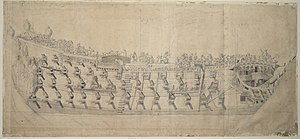 Portrait of the English ship Charles, circa 1776 by
Willem van de Velde the Elder
| |
| History | |
|---|---|
|
| |
| Name | HMS Charles |
| Builder | Christopher Pett and Jonas Shish, Deptford Dockyard |
| Launched | 10 March 1668 |
| Renamed | HMS St George, 1687 |
| Fate | Broken up, 1774 |
| General characteristics as built [1] | |
| Class and type | 96-gun first-rate ship of the line |
| Tons burthen | 1229 bm |
| Length | 128 ft (39 m) (keel) |
| Beam | 42 ft 6 in (12.95 m) |
| Depth of hold | 18 ft 6 in (5.64 m) |
| Sail plan | Full-rigged ship |
| Armament | 96 guns of various weights of shot |
| General characteristics after 1701 rebuild [2] | |
| Class and type | 90-gun second-rate ship of the line |
| Tons burthen | 1470 bm |
| Length | 162 ft 6 in (49.53 m) (gundeck) |
| Beam | 45 ft 5 in (13.84 m) |
| Depth of hold | 18 ft 7 in (5.66 m) |
| Sail plan | Full-rigged ship |
| Armament | 90 guns of various weights of shot |
| General characteristics after 1740 rebuild [3] | |
| Class and type | 1733 proposals 90-gun second-rate ship of the line |
| Tons burthen | 1655 bm |
| Length | 166 ft (51 m) (gundeck) |
| Beam | 47 ft 9 in (14.55 m) |
| Depth of hold | 19 ft 6 in (5.94 m) |
| Sail plan | Full-rigged ship |
| Armament |
|
HMS Charles was a 96-gun first-rate ship of the line of the Royal Navy, built by Christopher Pett at Deptford Dockyard until his death in March 1668, then completed by Jonas Shish after being launched in the same month. Her name was formally Charles the Second, but she was known simply as Charles, particularly after 1673 when the contemporary Royal Charles was launched. [1]
Charles was renamed HMS St George in 1687 and reclassified as a second rate in 1691. In 1699–1701 she was rebuilt at Portsmouth Dockyard as a 90-gun second rate. [2] In 1707, she belonged to Admiral Sir Cloudesley Shovell's fleet. Under the command of Captain James Lord Dursley, [4] she saw action during the unsuccessful Battle of Toulon and was present during the great naval disaster off the Isles of Scilly when Shovell and four of his ships ( Association, Firebrand, Romney and Eagle) were lost, claiming the lives of nearly 2,000 [5] sailors. St George also struck rocks off Scilly, but got off.
St George was taken to pieces at Portsmouth in 1726 to be rebuilt again. On 4 September 1733, St George was ordered to be rebuilt to the 1733 proposals of the 1719 Establishment. She was relaunched on 3 April 1740. [3]
She was eventually broken up in September 1774. [3]


Notes
- ^ a b Lavery, Ships of the Line vol.1, p. 161.
- ^ a b Lavery, Ships of the Line vol.1, p. 166.
- ^ a b c Lavery, Ships of the Line vol.1, p. 170.
- ^ James Herbert Cooke, The Shipwreck of Sir Cloudesley Shovell on the Scilly Islands in 1707, From Original and Contemporary Documents Hitherto Unpublished, Read at a Meeting of the Society of Antiquaries, London, 1 February 1883
- ^ Sobel, Dava, Longitude: The True Story of a Lone Genius Who Solved the Greatest Scientific Problem of His Time, Fourth Estate Ltd., London 1998, p. 6, ISBN 1-85702-571-7
References
- Lavery, Brian (2003) The Ship of the Line - Volume 1: The development of the battlefleet 1650-1850. Conway Maritime Press. ISBN 0-85177-252-8.
- Winfield, Rif (2009) British Warships in the Age of Sail 1603-1714: Design, Construction, Careers and Fates. Seaforth Publishing. ISBN 978-1-84832-040-6.
- Winfield, Rif (2007) British Warships in the Age of Sail 1714-1792: Design, Construction, Careers and Fates. Seaforth Publishing. ISBN 978-1-84415-700-6.
External links
-
 Media related to
HMS Charles (ship, 1668) at Wikimedia Commons
Media related to
HMS Charles (ship, 1668) at Wikimedia Commons